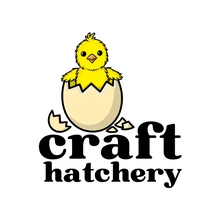So, you're ready to cross stitch? Fantastic! It's a fun and rewarding craft that anyone can enjoy. We're thrilled you're here, and we've put together this step-by-step guide to help you along the way. Craft Hatchery has a diverse library of PDF downloadable patterns available here. Remember, with a little patience and creativity, anything is possible! Let's get started!
View our beginner-friendly pattern here.
View our intermediate patterns here.
View our advanced patterns here.
What did the thread say to the embroidery needle? "X marks the spot"!

Here's What You'll Need:
Before we start poking fabric (in a therapeutic way), let's make sure you have everything you need:
- Cross Stitch Fabric: Aida and linen are your go-to options. Aida is beginner-friendly with easy-to-count holes and is the most commonly used, while linen is for those who like a challenge. Are you brave? Maybe. Read more about the fabrics here, in our complete guide to cross stitch fabrics!
- Embroidery Thread: This isn't regular thread, it's fancy thread! The thread bundle is called the skein, and the individual threads are called floss. Embroidery thread comes in hundreds of colors, and here's the best part: you get to pull it apart into 6 strands and then use just 2 or 3. Craft Hatchery patterns use 2 strands for regular cross stitch.
- Needles: Cross stitch needles have blunt tips, so you're far less likely to injure yourself (but not impossible). Size 26 is a good place to start.
- Embroidery Hoop: A small, fabric-tightening trampoline for your cross stitch. This hoop keeps your material tight and makes stitching easier, because stitching on wrinkly fabric is like trying to draw a straight line on a cat wound up on cat nip.
- Embroidery Scissors: Use these for snipping threads, not opening Amazon boxes. Trust me.
- Cross Stitch Pattern: Available in PDF and paper. Check out our pattern library here for some fun designs!
Step One: Find the Middle of the Fabric (and the Pattern)

To avoid running out of fabric mid-project, let's locate the center of both your fabric and pattern.
- Fold the fabric in half horizontally, then vertically. Unfold it and behold- creases that form quarters! The magic of geometry leads you straight to the center, and no need for Google Maps.
- Find the center of your pattern. Look for straight or dotted lines and arrows guiding you toward the middle. Use the center as your starting point.
Step Two: Prepare the Thread (No Knots, No Drama)
Now that we've got our center marked, let's talk thread. Specifically, how to pull floss without turning it into an uncontrollable tangled mess.
- Identify your thread color. Check your pattern for the color code (DMC threads have numbers, so it's like paint-by-numbers, but thread-by-numbers).
- Pull the floss from the numbered end of the skein. Trust me. This is crucial because pulling from the wrong end will create a tangled mess.
- Separate 2 strands from the skein (Most patterns call for 2 strands). To do this, grab a piece of floss as long as your forearm (wrist to shoulder). Now, the tricky part: grip the thread between your fingers and gently pull out a single strand. It might bunch up at first, but it will calm down.
Now, for the knotless start, because knots make the back of your project look lumpy, you want to avoid making them.
- Thread Your Needle. Fold the thread in half and thread both cut ends through the needle. If the thread frays, lick it. Seriously. It works. Just don't think about how weird it is that you're licking thread. You'll now have a little loop at the other end, ready to secure your thread when you begin stitching.
Step Three: The First Stitch
It's finally time to make your first stitch! This is where the magic happens. Well, after some poking around.
- Place your fabric in the embroidery hoop or Q-Snap. You want it nice and taut, like a tiny fabric drum.
- Start stitching! Start by threading your needle through the back of the fabric and pull it through to the front, but leave a little tail of thread hanging at the back (you'll tuck it in later).
- Secure your thread using the loop start. Your fabric grid is made up of little squares. Think of them as tiny dance floors where your needle will party. To make an "X," bring your needle up through the bottom left hole of a square and back down through the top right.
- Repeat this by coming up through the bottom right and down through the top left. Voila! You've made an X. Keep going with adjacent stitches. Cross stitches are just a series of X's on a line, stitched close together, so there are no gaps unless your pattern says so!
Step Four: Fastening Off (A Tidy Goodbye)
You've made it this far without utter chaos. Congratulations! Now let's talk about how to end a thread properly.
- When you're ready to switch colors, turn your fabric over. Pass your needle under 3 or 4 stitches at the back, pulling the thread taut.
- Snip the thread. Make sure you leave just a tiny bit at the end, and no knots! (Seriously, don't do knots. Your future self will thank you.)
- Design Completion. Once your entire design is done, remove it from the hoop and press it with a warm iron to smooth out the wrinkles. An excellent tip is to place a cloth over it so you don't scorch your hard work.
You Did It!
Congratulations, you've made it! I'm so glad you embarked on this journey, and we're excited to support you as you continue honing your cross-stitching skills toward perfection. To keep the creativity flowing, explore our pattern catalog here.
Happy stitching!

